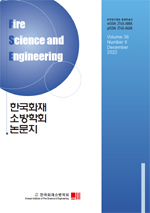동태적 회귀분석을 이용한 저항성누설전류(IGR) 결정요인 분석
Resistive Leakage Current (Igr) Determinant Analysis Using Dynamic Regression Analysis
- 한국화재소방학회
- 한국화재소방학회논문지
- Vol.36 No.6
-
2022.12158 - 164 (7 pages)
-
DOI : 10.7731/KIFSE.663db50a
- 14

전체 화재 원인 중 약 26%를 차지하고 있는 전기화재에 있어서 저항성누설전류(IGR)는 감전 및 전기화재와 같은 전기안전사고의 주된 원인으로 지목되고 있다. 이에 본 연구에서는 IoT 센서를 통해 실시간으로 수집된 전기데이터를 활용하여 저항성누설전류(IGR)의 결정요인을 실증적으로 분석하였다. 주요 결정요인들은 전기 요인, 날씨 요인, 건축물 요인으로 나누었으며 전기화재 단계를 위험과 비위험 단계로 나누어 IGR에 대한 영향을 구분하였다. 또한, 과거 시점의 IGR과 현재 시점의 IGR 간의 시차의존적 특성을 통제하기 위해 IGR 1시차값을 설명변수로 추가한 동태적 회귀모형을 이용하였다. 본 연구의 주된 분석결과는 다음과 같다. 전기 요인 중에서는 절연저항의 영향이 가장 컸으며, 영향의 강도는 위험 단계에서 더 크게 나타났다. 날씨 요인인 온도와 습도는 유의하였으나 IGR에 대한 영향의 강도는 작게 나타났다. 건물 요인 중 연면적 증가는 IGR을 감소시키는 반면, 높이 증가는 IGR을 증가시키는 것으로 나타났는데 그 영향 또한 위험 단계에서 더 컸다. IGR 1시차값은 현재의 IGR을 매우 크게 설명하는 것으로 나타났다. 특히, 비위험 단계보다는 위험단계에서 IGR 1시차값의 영향은 약화되는 반면에 다른 요인변수들의 영향은 강화된 것으로 나타났다. 이러한 결과는 위험 단계와 비위험 단계로 나누어 화재 확산 및 예후를 파악하는 것이 유용함을 보여준다.
In electrical fires, resistive leakage current (Igr) is considered as the main cause of electrical safety accidents such as electric shocks and fires. In this study, the determinants of the Igr were empirically analyzed using the electrical data collected in real time using the IoT sensor. An 1 lag Igr value (Igr data 1 h ago) was observed to significantly explain the current Igr. In particular, the influence of the 1 lag Igr value was weakened in the risk stage rather than the non-risk stage, whereas the influence of other factor variables was strengthened. This can be regarded as a dangerous sign of an electric fire, and the results of this analysis can be used to identify and predict the prognosis of future fires. These results show that the spread and prognosis of a fire can be understood by dividing it into risk and non-risk stages.
1. 서론
2. 본론
3. 결론 및 시사점
References
(0)
(0)